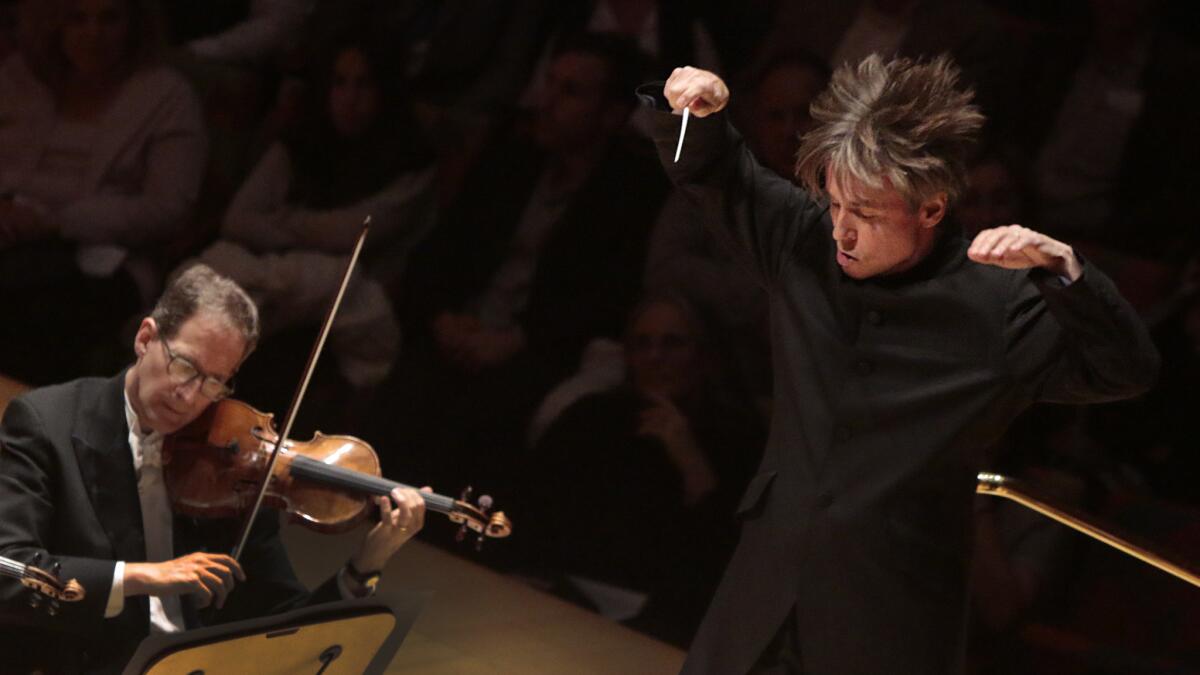Review: Salonen, Denk serve meat-and-potatoes Mozart, Beethoven

Theyâve turned back the clocks at Walt Disney Concert Hall to the 2000s. Esa-Pekka Salonen is back with his old colleagues, the Los Angeles Philharmonic, for three weeks, more than in any previous season since becoming conductor laureate.
For two of these three weeks, the programming has been and will be vintage Salonen. Last week focused spectacularly upon his interests and strengths â new music, Finnish music, new Finnish music, symphonic showpieces. Next week speculates on the future of concert music with the addition of interactive video.
Well, then, what to make of this weekâs programming, which consists of nothing but meat-and-potatoes Mozart and Beethoven? Unlike Salonenâs Beethoven Unbound series of several seasons ago, there was no contemporary composition there for contrast.
And while the Oct. 24 program attracted what looked like only a two-thirds-full house, Mozartâs Piano Concerto No. 20 in D minor and Beethovenâs âEroicaâ Symphony nearly filled the seats Thursday night. I leave it to you to draw the conclusions.
Not only was this an atypically conservative program for Salonen, it would seem to be equally so for pianist Jeremy Denk, last seen around these parts programming the Ojai Festival, which featured his hysterically funny new comic opera, âThe Classical Style.â So here was Denk, in league with a conductor who also has a wonderfully dry sense of humor, quite seriously and lovingly purveying the style that he sent up in that opera.
Anyway, there was little in the way of brooding or darkness in this performance of the D-minor concerto, with Salonen cultivating light, fast, clear, fluid work from the Philharmonic, with some muscular vigor in the finale, and Denk opening ruminatively yet with clearer definition and variety of color as the piece unfolded. The cadenzas were Denkâs own; the more-extensive one in the first movement opened conventionally by paraphrasing Mozart and developed momentum as it pushed somewhat ahead in time to middle-period Beethoven.
Shorn of its repeat, the first movement of the âEroicaâ was typical of what one remembered of Salonenâs Beethoven from his years as music director â light, fleet, breezy in an unimpeded roll to the finish line â and the second movement had only minimal gravitas.
However, the last two movements fared much better with his approach. The Scherzo had plenty of dash and fire at a racing pace, the variations of the Finale sped along with some forceful accents, the fugues beautifully played by the Philharmonic.
As Salonen once promised when writing about Beethoven Unbound, Beethoven the radical was present in this performance, but Iâm not sure if one could feel â as Brahms used to say â âthe tramp of a giant.â
More to Read
The biggest entertainment stories
Get our big stories about Hollywood, film, television, music, arts, culture and more right in your inbox as soon as they publish.
You may occasionally receive promotional content from the Los Angeles Times.










